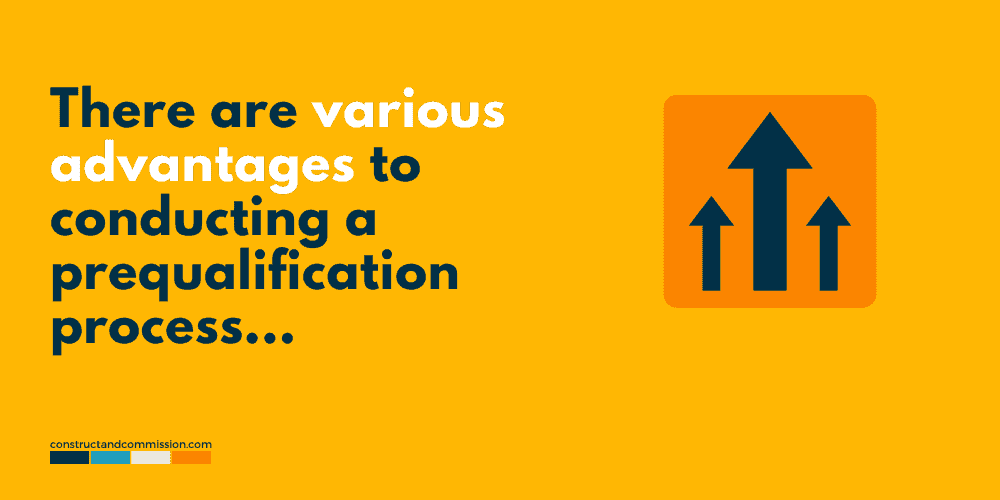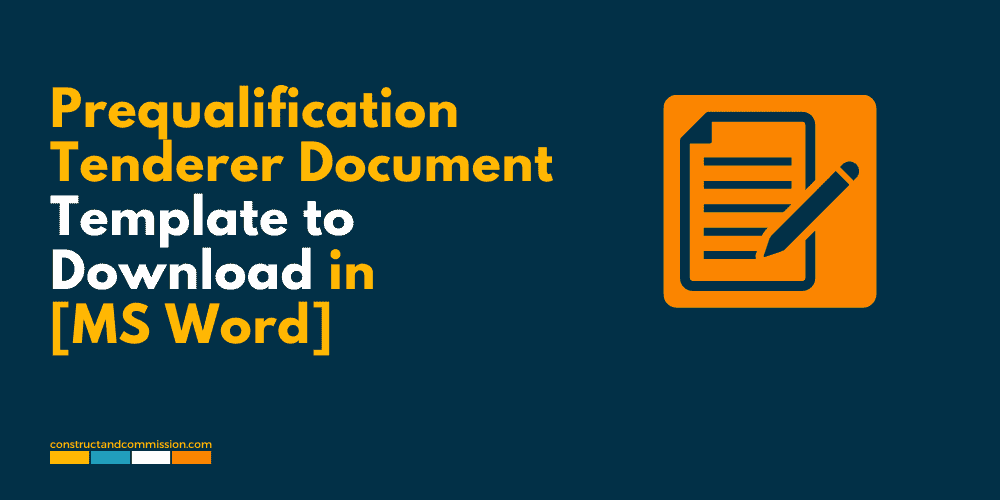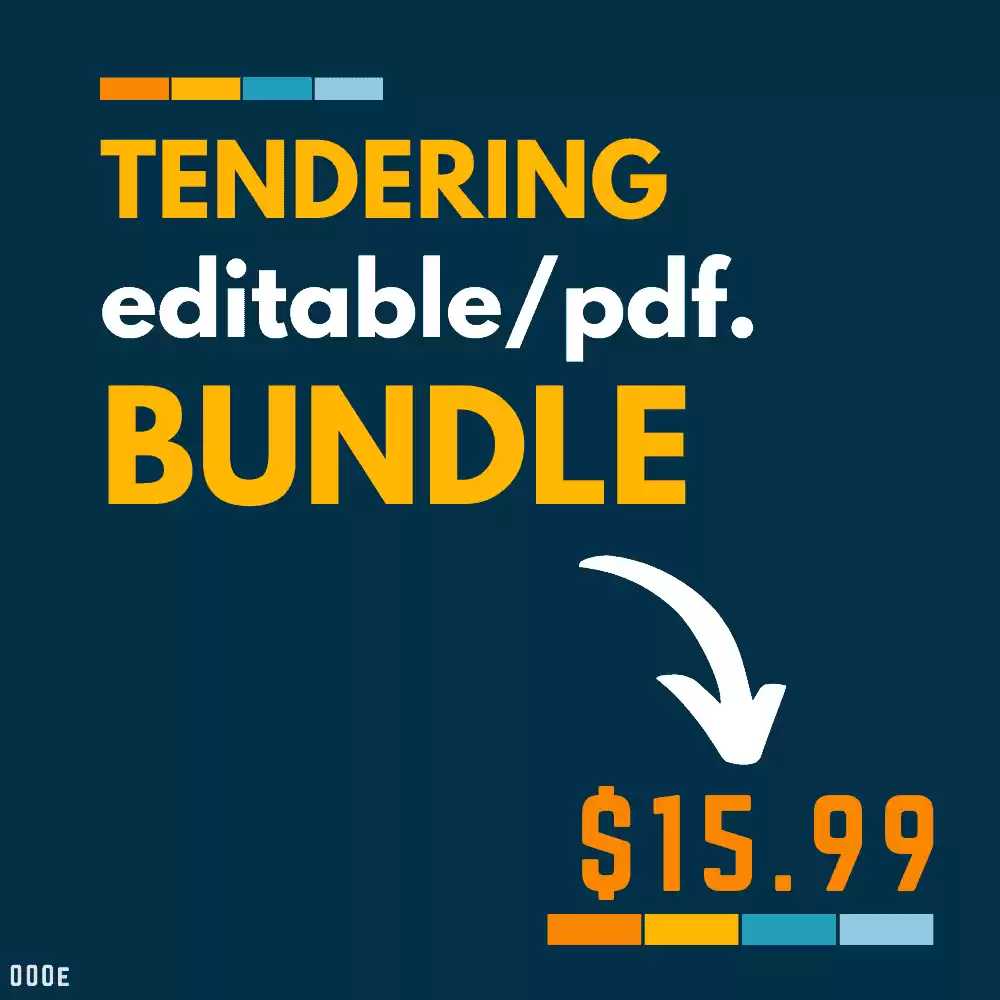Tendering can be very expensive, so clients use a formal pre-qualification / pre-selection process for selecting from a pool of bidders (contractors, suppliers, vendors, and consultants) to save time and project costs by quickly removing inexperienced or incapable tenderers and bidders, allowing only those capable and having the competence to provide a proposal.
🟩 Types of Projects Where a Pre-qualification Document Would be Used

There are many types of projects where this type of document would be used, below lists a few just for information:
- New Build Projects,
- Refurbishment Projects,
- Schools and Campus Building Projects,
- Commercial Construction Projects,
- Residential Construction Projects,
- Data Center Projects,
- Road Building Projects,
- Bridge Construction Projects.

🟩 Why Conduct a Pre-qualification / Pre-selection Process?
There are many advantages to completing this process; below, we have included a detailed list of the most common criteria that would be used, as can be seen below:
🟧 Tender Cost Saving.
Each tenderer included on the tendering list will need to be managed, evaluated, interviewed, questions responded to, and post-qualified. This, for each individual company, takes considerable time, effort, and resources.
The process helps manage these costs by removing companies that will not eventually meet the overall project requirements and expectations early in the process.
🟧 Tender Programme Savings.
Like the tender cost savings, managing the tendering process can take considerable time, resulting in extended programming times at the initial stages of the project.
The time spent on the overall tendering process can be reduced if companies are removed from the process, which will not meet the overall requirements.
🟧 Ensure the Contractor, Vendor or Consultant is a Responsible Business.
Clients usually avoid cowboys, preferring to employ reputable companies to carry out their work.
Understanding a company’s reputation, speaking to others who have dealt with them, and requesting references would aid this.
🟧 Ensure the Company has the required Financial Resources.
Depending upon the scale and size of a project or scope of work, a business’s financial accounts and creditworthiness would be evaluated to ensure they have sufficient resources and existing cash flow to purchase services and products in the initial stages and then see the project through to completion.
🟧 Insurances are as per the Project / Client Requirements.
All projects will require that companies delivering a service/scope hold the correct insurance.
These would usually cover the following:
- Builders risk,
- Commercial & contractor general liability,
- Errors & omissions,
- Professional liability,
- Professional indemnity,
- Auto/vehicle liability,
- Inland marine,
- Contractor bonds,
- Construction bonds,
- Workers compensation.
If you would like more insurance information, click here.
Here is an open copy of our PREQUALIFICATION TENDERER DOCUMENT, shown attached at the end of this article, to purchase for your use and light editing/modification if needed.
🟧 The Company holds the required Licences.
Depending upon the project’s location and type of work involved, there is usually a requirement for certain national and local licenses to be held by the potential bidders.
The clients will check that these are held, related to the works undertaken, and current.
🟧 The Company has No Outstanding Legal Issues.
As we know, there are a lot of risks associated with the construction industry, and sometimes, companies are taken to court.
The client will usually ask the companies and then have their team conduct checks to see if there are any ongoing cases or past cases that may affect the selection process.
🟧 Acceptance of Clients’ Terms and Conditions
Within the qualification document, the client will attach their terms and conditions for the project.
The tenderer will be expected to review and accept/comment on these terms.
🟧 There are no Conflicts of Interest.
A conflict of interest can be a problem for clients, especially when purchasing consulting services. So if it is noted that the general/main contractor owns shares in the 3rd party commissioning company being employed to validate their works, there is a future problem.
Clients prefer not to have conflicts and request that the companies confirm if they know of any.
Not all conflicts are an issue and will be reviewed on a case-by-case basis.
🟧 The Company has a Compliance Programme in place.
Due to the nature of our works, there are a few items that will need to be understood and considered when employing anyone on a project, especially one of size:
- Managing bribery and corruption,
- Due diligence reviews of potential suppliers, vendors, and contractors employed by the general/main contractor
Each tenderer should have a clear compliance program/document in place to manage both of these aspects.
🟧 The Company has a good Health & Safety Record.
Health and safety will be paramount to any project and client. The expectation is that all contractors, vendors, suppliers, and consultants ensure safe work practices are deployed fully in line with the client and legal requirements, with employees, contractors, and the public kept safe.
Contractors should provide evidence of their processes and plans to manage this and meet expectations.
🟧 Confident that the Company has Completed Similar Projects.
There is no point in giving a company with experience only building houses a project constructing their first multi-story office block or data center.
Contractors, vendors, suppliers, and consultants will be asked to provide evidence and references for similar projects with which they have delivered and been involved.
This will usually be in the form of a brochure and a list of projects and people who can be contacted if needed to verify the claims.
🟧 Expected Programme & Milestones are Achievable.
Clients like to have extremely aggressive timeframes; after all, they are not the ones building the job for the general delivery and certain milestones. They need to be confident that the companies tendering can deliver against it.
🟧 The Company has the Required Resources.
In line with the programme and milestones above, the correct quantity of resources, when needed, is critical to delivering the programme.
The contractors should be fully confident that they have the manpower and ensure their current workloads will not prevent the project delivery, and the client will ensure this is backed up with evidence later in the tendering process.
🟧 Resources have the correct Qualifications and Skillset.
A company with many available resources does not necessarily mean they are good resources. The tenderers will usually be asked to provide evidence of their qualifications and skillset/experience related to their role, responsibilities, and tasks for the project.
🟧 Resources are Local to the Project
To ensure that the local area, companies, and workforce benefit from the completed work, bidders should clearly state the [%] of operatives and staff employed locally and how many will be brought in due to expected skill shortages.
🟧 The Company has the correct Equipment, Tools, and Software to complete the work.
Depending upon the project, many different types of equipment, tools, instruments, and software are required to complete the scope. This could range from large earth-moving vehicles to instruments to measure a chiller’s sound pressure levels.
Clients should ensure that the tenderers have full access to this equipment and the experience to manage it onsite.

🟩 Who is Responsible for Conducting the Process?
The process will be overseen and managed by the client tendering team with input from the bidders.

🟩 9No. Steps for a Pre-qualification / Pre-selection Process
The following steps will usually be taken when conducting this process:
🟧 Step 1 – Understand the Scope/Delivery Required
Before the prequalification process, the client bid team should review the project/works package to understand the scope and delivery needed from the bidders.
Once fully understood, the next step can be completed.
🟧 Step 2 – Bidder/Tenderer List
Once the overall works package is understood, the client bid team will put together a list of potential bidders who, in their view, should be able to complete the works.
The number of bidders on the list could be upwards of 6 to 8 companies.
🟧 Step 3 – Create Prequalification Document
The client bid team/representative will create a prequalification document template that is intended to be issued to the tenderers on the list in Step 2 after approval by the Client.
[see our Prequalification Document Template after this section]
🟧 Step 4 – Issue Prequalification Document to Listed Tenderers
Once all are agreed, the client bid team will issue the prequalification document to the tenderer/bidders for their completion and return.
We have put together this bundle so you can get all related documents, and buying them together provides even better value [Over 50% Off], as shown below.
Included - 20 Tendering Steps Guideline Document | 20 Step Tendering Process Graphic | Tender Interview Agenda Example | Tender Interview Question Examples | Prequalification of Tenderer Document Template | CxA Request for Proposal [RFP] Template | CxA Scope of Work [SOW] Template | Acknowledgment of RFP/RFQ | Request For Information [RFI] Template | Request For Information [RFI] Tracker/Log.
🟧 Step 5 – Review of Responses
The client bid team will review all responses from the tenderers to evaluate their suitability to provide an overall cost on the project.
This would usually be conducted using a scoring matrix to ensure each company is reviewed equally and there are few means to be biased.
🟧 Step 6 – Recommendation to Client
Once the evaluation process has been completed, the bid team will provide their results and advise the Client on which tenderer should proceed and which should be removed from the process.
🟧 Step 7 – Update Tender/Bidder List
Once agreed with the Client, the Tenderer List will be updated, removing the companies that did not meet the prequalification requirements.
🟧 Step 8 – Notify Listed Tenderers
The bidding manager will notify each company individually, confirming if they have been selected to provide a proposal or if they were unsuccessful.
🟧 Step 9 – Issue Tender Documentation
Once all tender documentation is ready and consolidated, the bidding manager will issue it to the successful prequalification tenderers.

🟩 Do you need to Prequalify every Project/Supplier?
Not necessarily; sometimes, we work with contractors, suppliers, and consultants who we know well and who have previously been prequalified.
Where this is the case, we do not usually need to constantly qualify them, they should be qualified but perhaps once a year.
⬜ Prequalification Document Template Download
To help us expand the site and create more resources, we created the documentation below in [Microsoft Word] for download.
Click the ‘Buy Here’ button to purchase the fully editable copy of the document below, which can be used immediately.
You will direct to our shop page.
⬛ Related Articles
[RFI] REQUEST FOR INFORMATION | What is it in Construction with Templates
RFI vs RFQ vs RFP | Understanding the Differences
ACKNOWLEDGMENT OF RFP/RFQ | with Simple Letter and Email Template
TENDER BRIEFING SESSION | How to Conduct with downloads


![Prequalification Tenderer Document Template [MS Word]](https://constructandcommission.com/wp-content/uploads/2023/01/109-Pre-Qualification-Form-Tempalte-Sell.webp)
